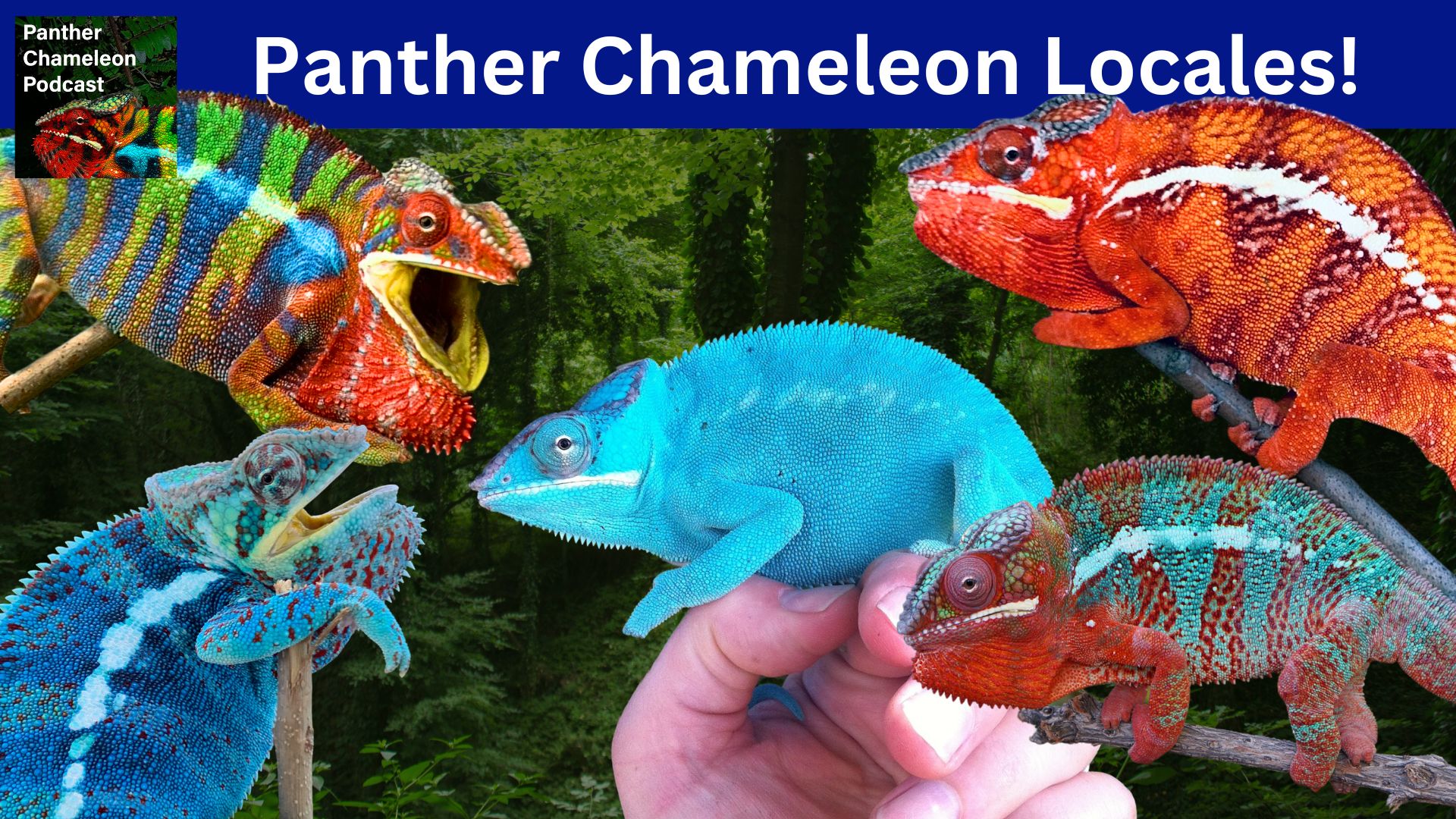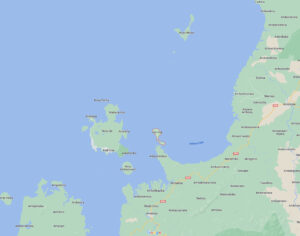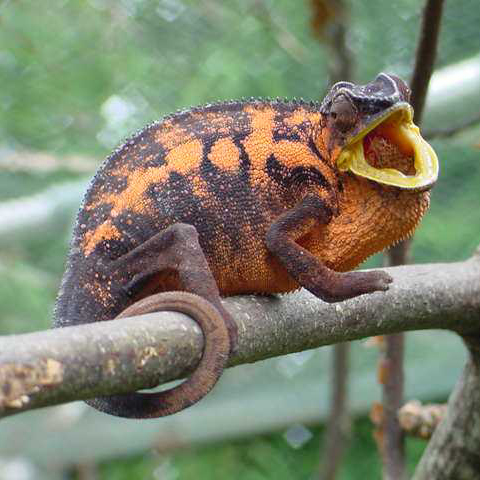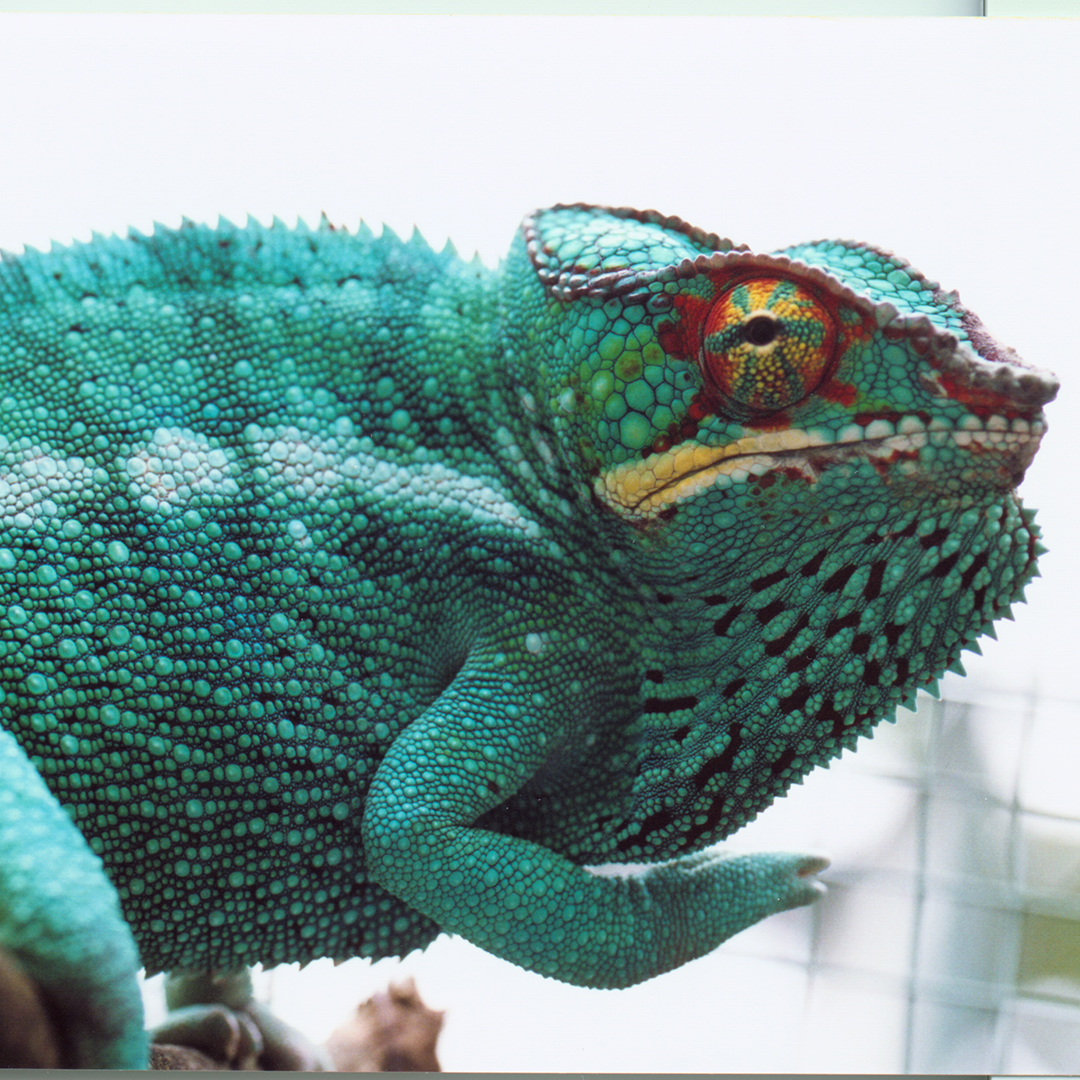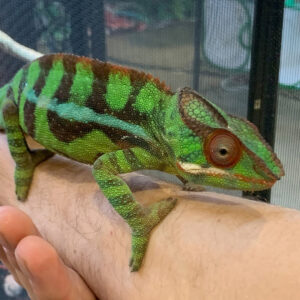Panther chameleons come in a rainbow of colors! This makes them one of the most desirable of chameleons. But what exactly are all these different colors and what does that mean for you as the new chameleon keeper?
Listen to this podcast episode!
Introduction to Finding a Panther Chameleon Breeder
The first thing that we notice and fall in love with when we meet the panther chameleon is the jaw dropping colors. It is hard to believe something like that is real! I got my first panther chameleon over 30 years ago and I still can’t believe they are real! So, let’s go ahead and dive into just what all this means.
Panther chameleons inhabit the coastal regions of Madagascar from around the central Eastern coast all the way around the Northern tip and down almost to the central Western coast. They also inhabit the various islands along the coast. And if you have heard of the locales Nosy Be, Nosy Faly, or Nosy anything, those come from islands. Nosy is the Malagasy word for island. Each of these locales has a certain color palette different from the others. So one locale will have a red base while another might have a blue base. But the red based panther will never turn blue. So there are limitations here.
The changes across the range are seen in the males. The females are a beautiful pink, salmon, brown or gray, but the females of all the locales show the same color variations so there is no way to tell the locale of the females just by looking at her. And those of you who are fans of foreshadowing will note that this will cause huge problems later in our story.
Panther chameleons range around the coasts of the Northern half of Madagascar. Range data is from IUCN Red List.
Terminology
The first question from the curious mind is, what is a locale? And are they different species? Can we call them morphs? So, let’s do a little definition of terms.
Now, I want to say that this is a general checklist and you should use your judgement as to the mix of things. In this social media driven world it would be easy for a very good breeder to be left behind because they haven’t kept up with the 253 changes Instagram has done in the last month or they haven’t figured out with a tik-tok is. Social media is a completely different skill from breeding so nonexistent social media is not a black mark. It just means it is much more difficult for you to give them the green flag unless you know someone personally who has dealt with them or some other way to gauge their competency. That said, there are a number of excellent breeders that do have an extensive social media presence that will allow you to check the boxes.
1. Locale
A locale is when we identify a color variation by where it originates. In Panther Chameleons, we identify them using the name of the closest town. Ambilobe, Ambanja, Ankaramy…these are all towns somewhere near where the panther population exists. For island forms we just use the name of the island. Nosy Be, for example, is an island and so the color variation from there is identified with the island name.
2. Species
A species or subspecies indicates enough of a physical difference that scientists determine that these are distinct populations. Where the dividing line is to determine if it is species or subspecies is sometimes murky and I would direct you to the Chameleon Academy Podcast episodes where I interview Dr. Mark Scherz who is a taxonomist working with Malagasy species. It is not an easy designation to explain. But that is why we have people like him. In the layman world, we often use the ability to breed together as a delimitation between species, but that is not scientifically accurate. And if you are confused then you can join me in thanking Mark for doing what he does and we will just accept that it is a physical and genetic difference. Panther Chameleons across their wide range are considered the same species and attempts to break them up in species or subspecies have yet to succeed. Regardless of present or future designations, all the color variations can interbreed. And, for those who enjoy foreshadowing, you see the plot thicken with complication once again.
3. Morph
A morph is a color variation that can occur in the same clutch. If I could get red bodied panthers, yellow bodies panthers, and blue bodied panthers from the same clutch it would be a morph. You see this in dogs. Shiba Inus can be red, black and tan, sesame, or white. And these can be in the same litter. So these would be morphs. Black panthers are another example. Some kittens in a litter will show the black coloration and some will show the standard yellow.
Now, you can always selectively breed to bring out certain traits and get more of one then the other, but, getting back to the conversation at hand, the panther chameleon colors are not morphs. I made this mistake before I dug down to figure out what all these terms meant. But I am getting you set off right from the beginning so you can look smarter than I did when I started.
3. Physical Characteristic
Another way that variations can be described is by some physical attribute. Parson’s Chameleons are a good example of this. You will hear Yellow-lipped, Orange-eyed, Yellow Giant, or Green Giant. And sometimes people argue back and forth what they should really be because these names are subjectively descriptive. I do not know why local description was not used for Parson’s Chameleons or colors were not used for Panther Chameleons. Things just start and they continue. I am glad we went with locale for Panther chameleons because coming up with different names for each variation would be a complete mess!
Differences between the locales of Panther Chameleons
All well and good. But what does that mean for you who just wants a panther chameleon? Luckily, it doesn’t mean much at all. Even though panthers have such a wide geographical range and will inhabit from sea level to 1000 meters in elevation, it appears that the care for them all is the same. So you only have to select a panther by your subjective preference in color. And, yes, that is not as easy as it may sound. Of all the things you have to do to get ready for a panther chameleon, picking the color ranks amongst the most stressful. How do you select between all these incredible colors? You literally could spend your entire chameleon keeping life with just the different locales of panther chameleons. You wouldn’t even need to look at any of the other 200 + species out there! So, Let’s go ahead and review some of the major options.
Now, I want to say that this is a general checklist and you should use your judgement as to the mix of things. In this social media driven world it would be easy for a very good breeder to be left behind because they haven’t kept up with the 253 changes Instagram has done in the last month or they haven’t figured out with a tik-tok is. Social media is a completely different skill from breeding so nonexistent social media is not a black mark. It just means it is much more difficult for you to give them the green flag unless you know someone personally who has dealt with them or some other way to gauge their competency. That said, there are a number of excellent breeders that do have an extensive social media presence that will allow you to check the boxes.
Ambilobe
By far, the most popular locale is the Ambilobe Panther Chameleon. This locale has the widest range of colors in one panther. The color patterns are generally a body color and a bar color. The bars are the saddle like patterns across the flanks of the panther. So you can have red body, blue bar or yellow body, blue bar or Red bars. I have a green body, red bar Ambilobe at rest that fires up to be a bright orange over all. So you have amazing diversity in one locale. This locale came into the trade relatively late in the early 2000s

Ambilobes have diverse color palettes. This one is a yellow bodied blue bar Ambilobe. The body is green at rest and changes to yellow for display.
Ambanja
The Ambanja locale is usually described at a bluish bodied panther with purplish saddles. And here is where it is time to discuss expectations. With may of these locales we have selected one color scheme to be the expected color for that locale. The problem is that each locale has a normal range of color variation so you can get an Ambanja that does not look like the color scheme we have decided is the standard. Ambanjas have been bred in captivity since the 90s and have produced some striking chameleons in the blueish color range. But they have great;y deviated from the standard that we assigned to Ambanja somewhere along the way.
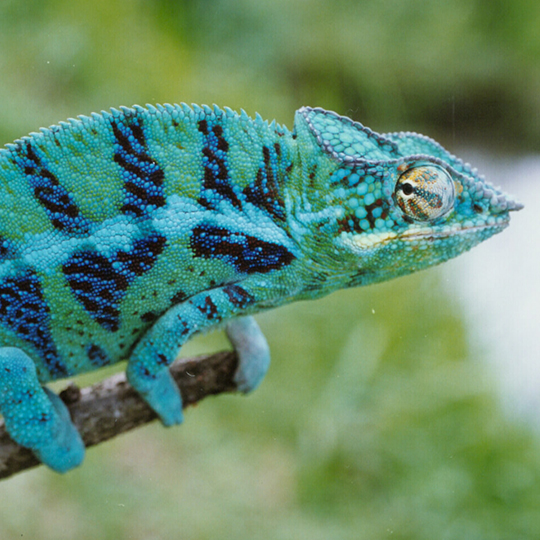
The Ambanja locale is usually considered a bluish-green body with bluish-purple “saddles” on the flank.
Nosy Be
Perhaps the most famous of the panthers is the blue panther. These were the most sought after before the Ambilobe became popular. The craze all started when a panther chameleon from the island Nosy Be was featured on the cover of the Vivarium magazine. The panthers on Nosy Be were a sea foam green bluish often with a sprinkling of red around the eyes. This individual, though, lacked yellow pigment and was left completely bubble gum blue. And the panther world went nuts trying to get one. This was a very rare form and Nosy Be was soon stripped of any panther that remotely resembled this one magazine model. Luckily, a number of breeders were able to get a hold of some of these and started captive bred lines that were further refined until it was reliable to be able to get a blue panther chameleon. And this is where the distinction between Nosy Be and Nosy Be Blue came to be. Nosy Be blues are a favorite of mine and continue to hold a special place in my heart.
Sambava
Sambavas are great for those who enjoy the yellow and red type colors. They have been long part of captive breeding programs. Although, the Ambilobes can have the same sorts of colors, Sambava’s continue to be reliably bred and available. Within our captive populations the Sambavas tend to be on the larger size.
Other Panther Chameleon Locales
There are may other locales that you may run into Nosy Faly, Nosy Mitsio, Ankaramy, Andapa, and you might be surprised at how there is always another locale name to learn. But none are as established as the main four: Ambilobe, Nosy Be, Ambanja, and Sambava. To be honest, don’t worry about all these other locales right now. The most colorful ones are represented and those bloodlines have been further refined by selective breeding so the colors of the captive bred panthers are actually more vibrant. And breeders are continually working towards selectively pairing for brighter resting colors. So, for your first panther, I suggest you not go down the rabbit hole of the myriad of locales. You will find the best of what panther chameleons can offer in the main four.
Mixed Panther Chameleon Locales
And now we touch on some controversy. Some breeders like to mix the locales to see if the result is double the color. This is rarely the case and the results often look like you mixing a bunch of crayons together. But, there are some notable exceptions that produce gorgeous panthers. The practice is controversial, though. And this is because once you mix locales you cannot unmix them. And, so, many breeders avoid doing so. So, what does this mean for you? Well, if you are just looking to get a pet it doesn’t mean much. If you find a gorgeous mixed locale panther then it will make as good of a pet as any. If you have any thoughts of breeding in the future, though, take a step back and reconsider whether you want to be involved with mixed locale panthers. They can be exceptionally hard to sell. Breeders won’t want the females and the males will go only to the general retail public. I suggest leaving mixed breed locales to the long time, firmly established breeders. At the very least, do not entertain that decision until you have your feet firmly planted underneath you in the chameleon community and you understand the pros, cons, and politics surrounding it.
Florida Panther Chameleons
A discussion about locales would not be complete without discussing the Florida population. Many years ago, panther chameleons established a population in Florida. The very sparse information I have is that this population is a mixed locale population and so we now have a Florida locale which turns up every now and then at shows and online. I do not have much information about this population as far as what their characteristics are, how healthy they are, and what their parasite load may be. What is important to you is to know they exist. But I would expect that only wild caught would usually be available. Wild caught is a red flag and mixed locale is a big caution. If someone did captive breed Florida panthers they probably would be fine as individual pets. But since there is no market for Florida panthers and breeders could fill those cages with a locale that is much more profitable for the same cost to raise them, be wary if anyone is selling the Florida locale.
Petr Necas has compiled a gallery of images of panther chameleons that were photographed in Florida that you can reference here: https://www.chameleons.info/en/furcifer-pardalis-florida/
Conclusion
To summarize every thing I went over in this episode
- Locale is a description of the area where the panther’s color palette originated
- Constant refining of captive bloodlines has brought out some interesting coloration that may not be typical from the area.
- Locales are cared for with the same husbandry
- Choice of Iocale is completely up to you with the pros and cons list being your color preference.
Links from the Podcast Episode
I hope this was a useful review of panther chameleon locales. This page is the partner to the podcast episode on the top of the page. The Panther Chameleon Podcast is part of the Chameleon Academy Outreach. On this Panther Chameleon Podcast, I take on aspects of starting with panther chameleons that will directly benefit a person just starting off. Please note that you have an entire detailed panther chameleon care summary here on chameleonacademy.com. This has been put together as a free resource to ensure the widest number of people can get a good start with their panther chameleon. If you would like to support this outreach you can do so at the Chameleon Academy Patreon page linked below and that helps keep this all running.
Getting a panther chameleon is a step to an incredible new world and an experience you will remember for your entire life. And I am going to do what I can to make sure it is a great one. If you would like to ask questions about any of this, check the Chameleon Academy home page for the schedule of when I do live interactive sessions on YouTube and Instagram.

